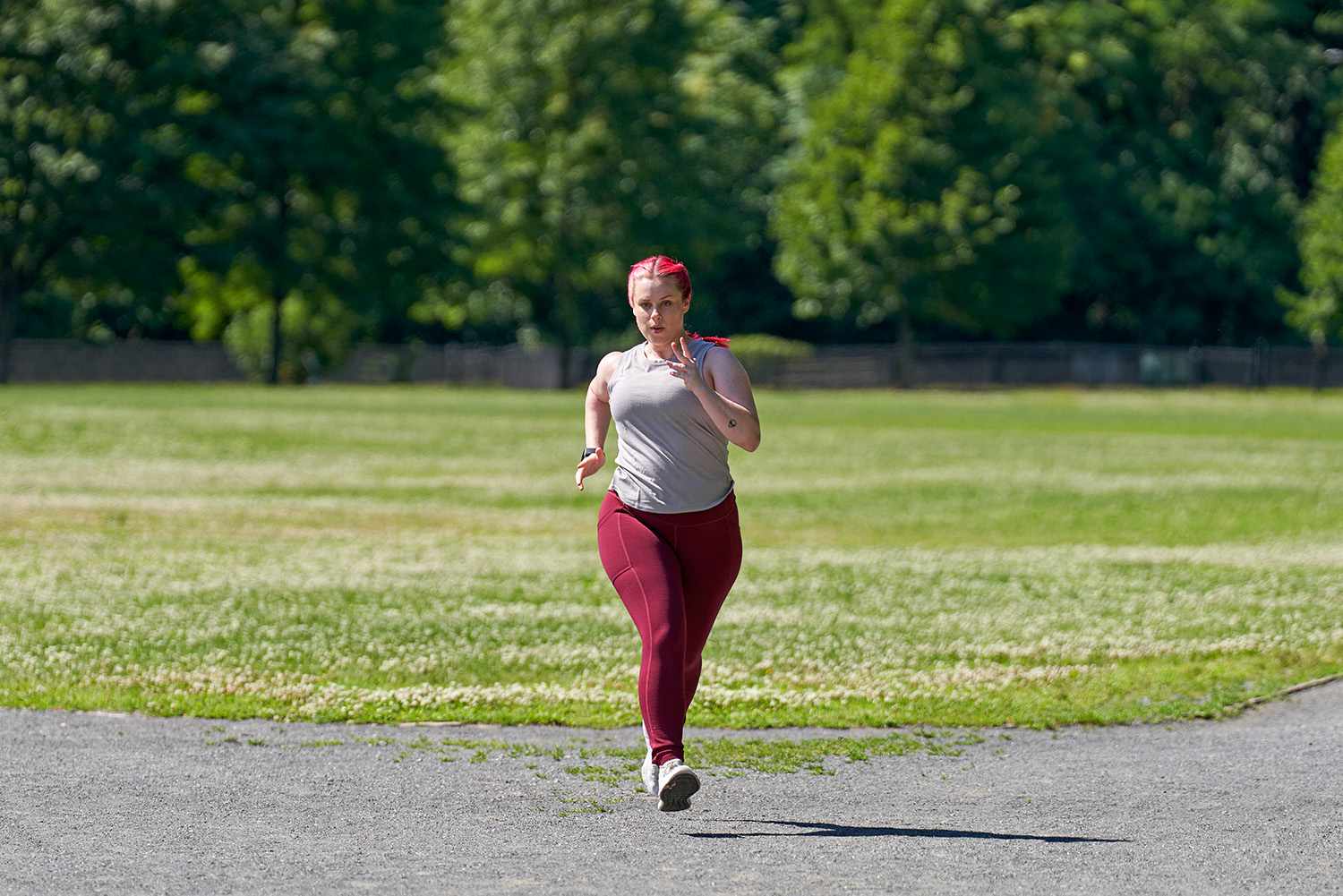

Featured
How To Start Jogging At 60
Modified: May 22, 2024
Start jogging at 60 with our featured tips and advice. Experience the health benefits and enjoy an active lifestyle at any age.
Introduction
Welcome to the exciting world of jogging! You may be thinking that starting to jog at the age of 60 seems like a daunting task, but let me assure you that it’s never too late to embrace a healthy and active lifestyle. Jogging is a fantastic way to improve your fitness, boost your mood, and enhance your overall well-being.
As we age, staying physically active becomes increasingly important. Regular exercise has been proven to reduce the risk of chronic conditions such as heart disease, diabetes, and even some types of cancer. It also helps to maintain a healthy weight, improve bone density, and strengthen muscles and joints. The good news is that jogging is a low-impact form of exercise that can be easily adjusted to match your fitness level and abilities.
In this article, we will explore the various benefits of jogging at the age of 60 and provide you with practical tips on how to get started. We will discuss the importance of proper warm-up and stretching techniques, as well as how to gradually increase your jogging intensity over time. Additionally, we will touch on setting realistic goals, staying consistent, and overcoming common challenges that may arise along the way.
Before we dive in, it’s important to note that it’s always a good idea to consult with your healthcare provider before starting any new exercise program, especially if you have any pre-existing health conditions or concerns.
Now, let’s lace up those shoes and hit the pavement! Jogging at 60 can be a truly rewarding and transformative experience that will not only benefit your physical health but also invigorate your mind and spirit.
Benefits of Jogging at 60
It’s no secret that regular exercise is crucial for maintaining good health and well-being, regardless of age. When it comes to jogging at the age of 60, there are numerous benefits that await you. Let’s explore some of the key advantages of incorporating jogging into your daily routine.
1. Improved cardiovascular health: Jogging is a fantastic aerobic exercise that gets your heart pumping and blood flowing. Regular jogging can help strengthen your heart, lower blood pressure, and improve circulation. It also helps reduce the risk of heart disease and stroke, which are common concerns as we age.
2. Enhanced joint flexibility and bone density: Jogging is a weight-bearing exercise that helps to strengthen bones and reduce the risk of osteoporosis. It also helps improve joint mobility, which is essential for maintaining independence and preventing injuries.
3. Mood enhancement: Jogging releases endorphins, also known as the “feel-good” hormones, which can help alleviate stress, anxiety, and symptoms of depression. It’s a natural mood booster that can leave you feeling happier, more relaxed, and mentally rejuvenated.
4. Weight control: As we age, maintaining a healthy weight becomes increasingly important. Jogging is a calorie-burning exercise that can help you shed unwanted pounds or maintain a stable weight. Combined with a balanced diet, jogging can contribute to weight management and promote overall body composition.
5. Increased muscle strength and toning: Jogging engages multiple muscle groups, including the calves, thighs, glutes, and core. Regular jogging can help improve muscle strength and tone, giving you better balance, stability, and overall body strength.
6. Boosted cognitive function: Engaging in regular physical activity, such as jogging, has been linked to improved cognitive function and a reduced risk of age-related cognitive decline. Jogging can enhance memory, attention, and overall brain health, keeping your mind sharp and focused.
7. Social interaction and connection: Jogging can be a great opportunity to connect with others, whether it’s through joining a running group, participating in charity runs, or simply jogging with a friend or loved one. It provides an opportunity to build friendships, share experiences, and stay socially engaged.
Jogging at the age of 60 is a powerful way to improve your overall quality of life. It’s not just about physical benefits but also about the positive impact on mental and emotional well-being. So, grab your running shoes and get ready to embrace the many rewards that await you on this incredible journey.
Preparing for Jogging
Before you hit the pavement and start jogging, it’s important to take a few steps to prepare yourself physically and mentally. Preparing properly will help prevent injuries and ensure a more enjoyable jogging experience. Let’s explore some essential tips to get you ready for your jogging journey.
1. Consult with your healthcare provider: It’s always a good idea to consult with your healthcare provider before starting any new exercise program, especially if you have any pre-existing health conditions or concerns. They can provide valuable insights and guidelines specific to your needs and capabilities.
2. Get the right footwear: Investing in a good pair of running shoes is crucial. Look for shoes that provide proper cushioning, support, and stability. Consider visiting a specialty running store where professionals can assess your foot type and help you find the perfect pair of shoes.
3. Start with a walking routine: If you’re new to exercise or have been inactive for a while, it’s a good idea to start with a walking routine before transitioning to jogging. Walking will help condition your muscles, joints, and cardiovascular system, preparing them for the higher impact of jogging.
4. Improve your flexibility: Flexibility is important for efficient, injury-free jogging. Incorporate stretching exercises into your routine to improve your flexibility and range of motion. Focus on stretching your calves, hamstrings, quadriceps, and hip flexors.
5. Strengthen your core and lower body: A strong core and lower body will provide stability and support during jogging. Include exercises that target your core, such as planks and ab exercises, as well as exercises that strengthen your leg muscles, such as squats and lunges.
6. Practice proper posture: Maintaining a good posture while jogging is essential for efficiency and injury prevention. Keep your head up, gaze forward, shoulders relaxed, and maintain a slight forward lean from your ankles. Avoid slouching or leaning too far forward.
7. Develop a warm-up routine: Before each jogging session, it’s crucial to warm up your body to increase blood flow and loosen up your muscles. Incorporate dynamic stretches, such as leg swings and arm circles, as well as light cardio exercises like walking or gentle jogging.
8. Consider cross-training: Incorporating other forms of exercise, such as swimming, cycling, or strength training, into your routine can help improve your overall fitness and prevent boredom. Cross-training can also give your body a break from the repetitive impact of jogging.
By following these preparatory steps, you’ll be well on your way to starting your jogging journey on the right foot. Remember to start slowly and gradually increase your intensity to avoid overexertion. Now, let’s move on to the next essential aspect of jogging – choosing the right gear to enhance your running experience.
Choosing the Right Gear
When it comes to jogging, having the right gear can make a world of difference in your comfort and overall running experience. Let’s dive into some key considerations when choosing the right gear for your jogging routine.
1. Running Shoes: Invest in a good pair of running shoes that provide proper support, cushioning, and stability. Look for shoes designed specifically for running, and consider getting fitted at a specialty running store to ensure the perfect fit for your feet and running style.
2. Moisture-Wicking Clothing: Choose clothing made from moisture-wicking fabrics that draw sweat away from your skin and allow it to evaporate quickly. This will help keep you dry and comfortable, even on longer runs.
3. Comfortable Clothing: Opt for lightweight, breathable clothing that allows freedom of movement. Avoid wearing cotton as it can become heavy and uncomfortable when soaked with sweat.
4. Proper Socks: Invest in high-quality running socks that provide cushioning, support, and moisture-wicking properties. Look for socks made from synthetic materials like polyester or nylon, or consider specialized running socks with extra padding in key areas.
5. Headgear: Depending on weather conditions, you may want to consider wearing a hat or visor to protect your face from the sun or keep your head warm in colder temperatures. Additionally, if you wear glasses, consider using a strap to secure them in place while jogging.
6. Reflective Gear: If you plan on jogging during low-light conditions or at night, make sure to wear reflective clothing or accessories to increase your visibility to drivers and other pedestrians.
7. Activity Tracker or GPS Watch: Using an activity tracker or GPS watch can help you track your distance, pace, and other important metrics. This can be a great tool for monitoring your progress and setting goals.
8. Accessories: Depending on your preferences, you may want to consider additional accessories such as a running belt for carrying essentials like keys or a phone, a hydration belt or handheld water bottle to stay hydrated, and compression sleeves or socks for added support and recovery.
Remember, the right gear will not only enhance your comfort but also contribute to your safety and overall enjoyment of jogging. It’s worth investing in quality items that will withstand the demands of regular use. Now that you’re geared up and ready to go, let’s move on to the importance of warming up and stretching before your jogging sessions.
Warming Up and Stretching
Before you start your jogging session, it’s crucial to warm up your body and perform proper stretching exercises. Warming up and stretching can help prevent injuries, improve your flexibility, and enhance your overall performance. Let’s explore the importance of warming up and stretching before jogging.
1. Warm-Up: Begin your warm-up routine with five to ten minutes of light cardio exercises, such as brisk walking or gentle jogging. This increases your heart rate, raises your body temperature, and prepares your muscles for the upcoming activity.
2. Dynamic Stretches: Dynamic stretches involve controlled, repetitive movements that mimic the range of motion used during jogging. Examples of dynamic stretches include leg swings, arm circles, walking lunges, and high knees. These stretches improve joint mobility and increase blood flow to your muscles.
3. Stretching Exercises: After your warm-up, perform static stretching exercises that target the major muscle groups used during jogging. Hold each stretch for 20 to 30 seconds without bouncing or overstretching. Focus on stretches for your calves, hamstrings, quadriceps, hip flexors, and glutes.
4. Benefits of Stretching: Stretching helps improve flexibility, allowing for a wider range of motion in your joints. It also helps lengthen your muscles, preventing them from becoming tight and reducing the risk of muscle strains or pulls during jogging. Stretching can also reduce muscle soreness after your run.
5. Pay Attention to Your Body: Listen to your body as you warm up and stretch. If you feel any pain or discomfort, adjust or modify the stretches accordingly. It’s important not to overstretch or push yourself too hard, as this can lead to injuries.
6. Incorporate Foam Rolling: Adding foam rolling to your routine can provide additional benefits for muscle recovery and flexibility. Foam rolling targets trigger points and knots in your muscles, releasing tension and improving blood circulation. Use a foam roller to gradually roll over various muscle groups, focusing on areas that feel tight or tense.
7. Warm-Up and Stretching Tips: Remember to perform your warm-up and stretching routine before every jogging session. It should be a regular part of your routine to prepare your body for the physical demands of jogging. If you’re short on time, prioritize your warm-up and dynamic stretches, focusing on the muscles that will be most active during your run.
By incorporating a proper warm-up and stretching routine into your jogging sessions, you’ll minimize the risk of injuries and maximize your performance. Your muscles will be primed and ready to go, ensuring a smoother and more enjoyable jogging experience. Now that you’re warmed up, let’s explore how to gradually build your jogging intensity over time.
Start Slow and Gradually Increase Intensity
When starting your jogging journey at the age of 60, it’s important to take a gradual approach to avoid overexertion and minimize the risk of injuries. Starting slow and gradually increasing the intensity of your runs will allow your body to adapt and build endurance over time. Let’s explore some key tips to help you start and progress safely.
1. Begin with a Walk-Jog Approach: If you’re new to jogging or haven’t exercised for a while, start with a walk-jog approach. Alternate between periods of brisk walking and slow jogging. For example, you can begin by walking for 5 minutes, jogging lightly for 1 minute, and then repeating this cycle for a total of 20-30 minutes. Gradually increase the duration of your jogging intervals as you build your fitness level.
2. Incorporate Interval Training: Interval training involves mixing periods of higher intensity with periods of lower intensity or rest. It can help improve your cardiovascular fitness and increase your running endurance. Start by integrating short bursts of faster running into your routine. For instance, after a warm-up, jog at a comfortable pace for 3 minutes and then increase your speed for 30 seconds. Repeat this pattern several times, gradually increasing both the duration of the faster intervals and the number of repetitions.
3. Follow the 10% Rule: As a general guideline, avoid increasing your total running mileage or duration by more than 10% each week. This gradual progression gives your body time to adapt and recover between workouts. Pushing yourself too hard or too quickly can lead to fatigue, burnout, and potential injuries.
4. Use a Heart Rate Monitor: Monitoring your heart rate can help ensure that you’re exercising at an appropriate intensity level. Maintain a conversation-friendly pace, where you can speak comfortably without feeling out of breath. As your fitness improves, you may find that you can maintain a faster pace while still being able to hold a conversation.
5. Listen to Your Body: Pay attention to how your body feels during and after your runs. If you experience pain, excessive fatigue, or prolonged muscle soreness, it may be a sign that you’re pushing yourself too hard. Give yourself extra rest days or scale back your intensity to allow for proper recovery.
6. Set Realistic Goals: Setting realistic and achievable goals is important for maintaining motivation and tracking progress. Start with small milestones, such as running for a certain distance or duration without stopping, and gradually work your way up. Celebrate these accomplishments to stay motivated on your jogging journey.
7. Embrace Rest and Recovery: Rest and recovery days are just as important as your training days. Your body needs time to repair and rebuild muscle tissues after each workout. Incorporate rest days into your schedule and prioritize adequate sleep, hydration, and nutrition to support your body’s recovery process.
By following these tips and taking a gradual approach, you can safely progress in your jogging journey. Remember, it’s not a race, and every step forward is a step toward improved fitness and well-being. Stay consistent and patient, and you’ll soon discover the joys and benefits of jogging at 60.
Incorporating Interval Training
Interval training is a highly effective and efficient method to enhance your jogging routine at the age of 60. It involves alternating between periods of higher intensity exercise and lower intensity or rest periods. This form of training can significantly improve cardiovascular fitness, increase calorie burn, and boost your overall endurance. Let’s dive into the benefits and steps to incorporate interval training into your jogging sessions.
1. Increased Cardiovascular Fitness: Interval training pushes your cardiovascular system to work harder, leading to improved aerobic capacity. This results in a stronger heart and lungs, allowing you to sustain a faster pace for longer periods.
2. Calorie Burn and Weight Management: Interval training is a great way to maximize calorie burn during and after your workout. The high-intensity intervals elevate your heart rate, increasing the number of calories you burn during your session. Additionally, interval training stimulates your metabolism, causing it to stay elevated for hours after your workout, aiding in weight management.
3. Enhanced Endurance: Incorporating interval training into your jogging routine helps improve your overall endurance. It trains your body to adjust to different intensities, preparing you for faster and longer runs as you progress.
4. Varied and Engaging Workout: One of the advantages of interval training is the variety it brings to your workout. It breaks up the monotony of a steady jogging pace, keeping you mentally stimulated and engaged throughout your session.
5. Getting Started with Interval Training:
a. Warm-up: Begin with a 5-10 minute warm-up, consisting of light jogging or brisk walking to prepare your muscles and increase your heart rate.
b. Interval Intensity: Identify your target intensity for the high-intensity intervals. This should be a challenging pace that allows you to work at around 80-90% of your maximum effort.
c. Work-to-Rest Ratio: Determine the duration of your high-intensity intervals and the length of your rest or recovery periods. Start with a ratio of 1:2, where your high-intensity interval is half the duration of your rest period.
d. Example Workout: Begin with a 30-second high-intensity interval followed by a 60-second recovery period. Repeat this pattern for 8-10 cycles, gradually increasing the duration of your intervals and reducing the duration of your rests as you progress.
e. Cool Down: Finish your workout with a 5-10 minute cool down, consisting of light jogging or walking, followed by static stretching to help reduce muscle soreness and promote recovery.
6. Listen to Your Body: It’s crucial to listen to your body during interval training. Pay attention to how you feel, your breathing, and any signs of discomfort or fatigue. Adjust the intensity and duration of your intervals to match your fitness level and gradually progress over time.
7. Recovery and Rest: Remember to incorporate rest days between your interval training sessions to allow your body to recover and rebuild. Alternate interval training days with steady-state runs or other forms of exercise to maintain a balanced fitness routine.
Incorporating interval training into your jogging routine can bring a whole new level of challenge and improvement to your fitness. Be consistent, gradually progress, and enjoy the benefits of increased cardiovascular fitness, calorie burn, and enhanced endurance. Keep pushing your limits, and you might be surprised at what you can achieve.
Listening to Your Body’s Signals
When it comes to jogging at the age of 60, it’s crucial to listen to your body’s signals and respond accordingly. Paying attention to how your body feels during and after your runs can help you prevent injuries, avoid overexertion, and ensure a safe and enjoyable jogging experience. Let’s explore the importance of tuning in to your body and understanding its messages.
1. Recognize your limits: Each person’s fitness level and capabilities are unique. It’s essential to understand your limits and work within them. Respect your current level of fitness and gradually progress at a pace that feels comfortable for you.
2. Monitor your breathing: Pay attention to your breathing pattern during your jog. It should be steady and controlled. If you are gasping for breath or struggling to speak in short phrases, you may be pushing yourself too hard. Slow down and allow yourself to catch your breath.
3. Be aware of pain and discomfort: While some muscle soreness is normal, it’s important to distinguish between muscular fatigue and pain that may indicate an injury. If you experience sharp or persistent pain, stop jogging and seek medical attention if necessary.
4. Understand the difference between muscle soreness and injury: Muscle soreness after a run is common and typically resolves within a day or two. However, if you experience pain that worsens with movement or persists for an extended period, it could indicate an injury. Rest, ice, and seek professional advice if needed.
5. Embrace rest days: Rest days are just as important as your jogging days. They allow your body to recover, repair, and rebuild muscle tissues. Listen to your body’s signals for fatigue and take rest days when needed.
6. Adjust your pace and distance: If you find that your body is struggling to maintain a certain pace or distance, don’t be afraid to adjust and slow down. Listen to your body’s signals of fatigue and modify your running plan accordingly. The goal is to find a pace that is sustainable and comfortable for you.
7. Stay hydrated: Dehydration can have adverse effects on your performance and overall well-being. Pay attention to your body’s thirst signals and ensure you are properly hydrated before, during, and after your runs. Drink water regularly throughout the day, especially in warmer weather.
8. Respect your body’s need for recovery: Adequate recovery is essential for your body to adapt to the demands of jogging. Alternate between different types of exercise, incorporate rest days, and prioritize quality sleep to give your body the time it needs to recover fully.
Remember, your body is unique, and everyone’s jogging journey is different. By listening to your body’s signals, you can make informed decisions that promote your safety, well-being, and long-term enjoyment of jogging. Cherish the opportunity to connect with your body and respond positively to its needs. Happy jogging!
Setting Realistic Goals
Setting realistic goals is an important aspect of your jogging journey at the age of 60. It helps provide direction, motivation, and a sense of achievement as you progress. By setting goals that are attainable and tailored to your abilities, you can stay focused and ensure a positive and rewarding experience. Here are some key tips for setting realistic goals for your jogging routine.
1. Assess your current fitness level: Begin by evaluating your current fitness level. Consider factors such as your endurance, pace, and any limitations or health concerns. This assessment will serve as a starting point to establish goals that are appropriate for your abilities.
2. Use the SMART framework: Apply the SMART (Specific, Measurable, Achievable, Relevant, Time-bound) framework when setting your goals. Ensure that your goals are specific, such as aiming to jog for a certain distance or duration. Make them measurable, allowing you to track your progress and celebrate milestones along the way. Set goals that are achievable and relevant to your overall fitness and well-being. Finally, establish a timeframe for achieving your goals, whether it’s weeks, months, or longer.
3. Start with short-term goals: Begin with short-term goals that are achievable in the near future. These goals can help build your confidence, maintain motivation, and provide a sense of accomplishment. Examples may include jogging for 20 minutes without stopping or completing a certain distance comfortably.
4. Gradually increase the challenge: As you achieve your short-term goals, gradually increase the challenge. This progression may involve increasing distance, improving your pace, or incorporating more challenging routes into your jogging routine. Be patient with yourself and listen to your body as you push your limits.
5. Balance effort and recovery: Ensure that your goals strike a balance between pushing yourself and allowing for proper recovery. While it’s essential to challenge yourself, it’s equally important to prioritize rest and give your body time to adapt to the demands of jogging. Remember that progress is not always linear, and some days may be more challenging than others.
6. Celebrate milestones: Celebrate your achievements along the way, no matter how small they may seem. Recognize and appreciate your progress, whether it’s running a little faster, completing a longer distance, or consistently sticking to your jogging routine. Celebrating milestones reinforces positive behavior and helps build confidence and motivation.
7. Be adaptable and flexible: Be open to adjusting your goals as needed. Factors such as weather conditions, personal circumstances, and potential setbacks may affect your ability to achieve specific goals within a given timeframe. Being adaptable and flexible allows you to adapt to these challenges and make adjustments to your goals as necessary.
8. Embrace the journey: Finally, remember that the journey itself is as important as the goals you set. Embrace the process of self-improvement, self-discovery, and the joy of jogging. Enjoy the physical and mental benefits that come with it, and celebrate the small victories along the way.
By setting realistic goals, you create a roadmap for your jogging journey and ensure that you’re continuously challenging yourself while maintaining a positive and sustainable approach. With determination, perseverance, and a clear vision, you can achieve remarkable things while enjoying the journey to a healthier and more active lifestyle.
Staying Consistent
Consistency is key when it comes to establishing a successful jogging routine at the age of 60. Making jogging a regular part of your life brings numerous benefits, both physical and mental. By staying consistent and committed to your routine, you can maximize these benefits and enjoy a sustainable and fulfilling jogging practice. Here are some tips to help you stay consistent with your jogging regimen.
1. Set a schedule: Establish a regular schedule for your jogging sessions. Consistency is built by making jogging a non-negotiable part of your daily or weekly routine. Determine the days and times that work best for you and stick to them as much as possible.
2. Find an accountability partner: Having an accountability partner can significantly boost your motivation and help you stay consistent. Find a jogging buddy, join a local running group, or even enlist the support of a family member or friend. Knowing that someone else is counting on you can provide additional motivation and help you stay on track.
3. Set reminders: In the busy pace of everyday life, it’s easy to forget or push aside our commitments. Set reminders on your phone or use a planner to remind yourself of your jogging sessions. Treat them as important appointments that you can’t miss.
4. Start small, but be committed: When starting your jogging routine, it’s better to start small and be committed rather than trying to take on too much too soon. Set realistic goals that are achievable and build from there. Even a short jog or a brisk walk can make a difference when done consistently.
5. Stay motivated and inspired: Motivation can wax and wane, so it’s important to find ways to continually stay inspired. Follow jogging-related social media accounts, read success stories, and educational articles. Surround yourself with positive influences that remind you of the benefits and joys of jogging.
6. Embrace the power of habit: Transform jogging into a habit by making it a consistent part of your daily or weekly routine. Over time, it will become second nature, and the urge to run will become automatic. Use the power of habit to stay consistent and make jogging an integral part of your lifestyle.
7. Adapt to life’s challenges: Life is full of unexpected events and challenges that may disrupt your jogging routine. Although flexibility is important, it’s also crucial to adapt and find alternative ways to stay active during those times. Incorporate other forms of exercise or find creative solutions to maintain your commitment to physical activity.
8. Reward yourself: Celebrate your consistency by rewarding yourself at key milestones. Treat yourself to a massage, buy new running gear, or enjoy a day of relaxation. Rewards can help reinforce your commitment and keep you motivated to continue with your jogging routine.
Staying consistent with your jogging routine may require effort and dedication, but the benefits are well worth it. By setting a schedule, finding support, staying motivated, and embracing consistency as a habit, you’ll create a solid foundation for long-term success and enjoyment of your jogging practice. Remember, every step you take brings you closer to a healthier and fulfilling lifestyle.
Proper Hydration and Nutrition
Proper hydration and nutrition are essential components of a successful jogging routine at the age of 60. Fueling your body with the right nutrients and maintaining adequate hydration levels will optimize your performance, support recovery, and enhance overall well-being. Let’s explore some key tips for maintaining proper hydration and nutrition as part of your jogging practice.
1. Hydration:
– Drink water before, during, and after your jogging sessions to replace the fluids lost through sweat.
– Ensure you’re adequately hydrated throughout the day, not just during your runs.
– Monitor your urine color; pale yellow indicates proper hydration, while dark yellow may indicate dehydration.
– Consider carrying a water bottle or planning your routes near water sources to stay hydrated during longer runs.
2. Pre-Run Nutrition:
– Eat a balanced meal containing carbohydrates, protein, and healthy fats a few hours before your run. This will provide sustained energy during your workout.
– Choose easily digestible foods to avoid discomfort or cramping during exercise.
– Opt for complex carbohydrates such as whole grains, fruits, and vegetables to fuel your run.
3. Fueling During Your Run:
– For longer runs lasting more than an hour, consider consuming simple carbohydrates to provide immediate energy. This can include energy gels, sports drinks, or small snacks like bananas or energy bars.
– Experiment with different fueling strategies during your runs to find what works best for your body.
4. Post-Run Recovery:
– Refuel your body within 30 to 60 minutes after your jog with a combination of carbohydrates and protein. This will aid in muscle recovery and glycogen replenishment.
– Rehydrate by drinking water or electrolyte-rich beverages to replace any fluids lost during exercise.
– Consider incorporating foods high in antioxidants, such as berries and leafy greens, to reduce inflammation and aid in recovery.
5. Balanced Nutrition:
– Maintain a well-balanced diet that includes lean protein, whole grains, fruits, vegetables, and healthy fats.
– Consume foods rich in vitamins and minerals to support overall health and optimal performance. This includes foods like nuts, seeds, fish, and leafy greens.
6. Listen to Your Body:
– Pay attention to how your body responds to different foods and adjust your diet accordingly.
– Experiment with timing, portion sizes, and food combinations to find what works best for your energy levels and digestion.
7. Consult a Registered Dietitian:
– Consider consulting with a registered dietitian who can provide personalized guidance and help you develop a nutrition plan tailored to your specific needs and goals.
Proper hydration and nutrition are crucial for optimizing your jogging performance and promoting overall health and well-being. Making conscious choices to hydrate adequately, fuel your body with nutrient-dense foods, and listen to your body’s signals will ensure that you have the energy and resources needed to enjoy your jogging routine to the fullest.
Cooling Down and Stretching After Jogging
Cooling down and stretching after your jogging sessions is just as important as warming up before. A proper cooldown allows your body to gradually transition from intense exercise to a resting state, helping prevent muscle soreness and promote recovery. Stretching after jogging also helps improve flexibility, reduce muscle tension, and enhance overall flexibility. Let’s explore the benefits and best practices for cooling down and stretching after your jog.
1. Cooling Down:
– Gradually reduce your jogging pace and intensity during the final five to ten minutes of your run.
– Continue to move around at a slower pace, such as walking or similar low-intensity exercises, for another five to ten minutes.
– This gradual reduction in intensity allows your heart rate, blood pressure, and body temperature to gradually return to their resting state.
2. Benefits of Cooling Down:
– Reduces the risk of dizziness or fainting that can occur when stopping abruptly from intense exercise.
– Allows for the proper redistribution of blood flow throughout your body, helping remove waste products such as lactic acid and promoting recovery.
– Helps your muscles gradually relax, reducing the likelihood of muscle cramps or post-exercise soreness.
3. Stretching After Jogging:
– Engage in static stretching exercises targeting the major muscle groups used during jogging, such as your calves, hamstrings, quadriceps, and hip flexors.
– Hold each stretch for 20 to 30 seconds, avoiding bouncing or excessive force. Breathe deeply and relax into each stretch.
4. Benefits of Stretching After Jogging:
– Improves flexibility and range of motion, preventing muscles from becoming stiff or tight after exercise.
– Enhances overall muscle balance and mitigates the risk of muscle imbalances or injuries caused by tightness in certain muscle groups.
– Promotes relaxation and reduces post-workout muscle tension, helping you unwind and recover more effectively.
5. Foam Rolling:
– Consider using a foam roller or other self-massage tools to further release muscle tension and tightness after jogging. Roll gently along your major muscle groups, focusing on areas that feel particularly tight or knotted.
– Use slow and controlled motions, applying pressure to areas of discomfort, but avoiding any sharp pain.
6. Listening to Your Body:
– Pay attention to any discomfort or pain during cooldown or stretching exercises. Modify or cease any movement if you experience sharp or prolonged pain.
– Be mindful of your body’s feedback and adjust the duration and effort of your stretches accordingly.
7. Incorporating Other Recovery Practices:
– Consider other recovery practices such as hydrating, refueling with a post-workout snack or meal, and utilizing techniques like ice or gentle massage if necessary.
– Prioritize rest and allow your muscles time to recover before engaging in intense exercise again.
By incorporating proper cooling down and stretching into your jogging routine, you can support your body’s recovery, improve flexibility, and reduce the risk of post-workout discomfort or injury. Make cooling down and stretching a regular part of your jogging ritual to enhance your overall well-being and maximize the benefits of your exercise sessions.
Dealing with Common Challenges
Embarking on a jogging journey at the age of 60 may pose a few challenges along the way. It’s important to recognize these challenges and develop strategies to overcome them. By doing so, you can stay motivated, adapt to obstacles, and achieve your jogging goals. Let’s explore some of the common challenges you may encounter and practical tips to overcome them.
1. Lack of Motivation:
– Set clear and achievable goals that inspire and motivate you. Break down larger goals into smaller milestones for a sense of accomplishment.
– Find a jogging buddy or join a running group to stay accountable and motivated. Engaging with like-minded individuals can provide the support and encouragement you need.
– Vary your running routes to keep your environment fresh and exciting. Discovering new paths can add a sense of adventure to your jogging routine.
2. Aging-Related Concerns:
– Listen to your body and adjust your jogging routine accordingly. Be mindful of any joint discomfort and modify your intensity or surface as needed.
– Incorporate strength and flexibility exercises to support joint health and improve overall stability.
– Consult with a healthcare professional to address any specific concerns or develop a tailored exercise plan.
3. Inclement Weather:
– Dress appropriately for different weather conditions by layering your clothing, wearing a hat, and ensuring visibility in low-light situations.
– If outdoor conditions are not suitable, explore alternatives like jogging on a treadmill or engaging in indoor activities that provide a similar cardiovascular workout.
4. Time Constraints:
– Incorporate jogging into your daily routine by scheduling specific times for your runs. Prioritize it as an essential part of your day.
– Split your jogging session into smaller bouts throughout the day if time is limited. Even multiple shorter runs can provide significant benefits.
5. Overcoming Plateaus:
– Mix up your jogging routine by incorporating interval training, hill runs, or trying different types of runs (e.g., tempo runs, fartlek runs) to challenge your body.
– Include cross-training activities like cycling, swimming, or strength training to improve overall fitness and prevent plateauing.
– Consider hiring a running coach or seeking advice from experienced runners to gain new insights and fresh perspectives.
6. Dealing with Injury:
– Listen to your body and take any discomfort or pain seriously. Rest and allow yourself time to recover from injuries, seeking medical attention if necessary.
– Focus on rehabilitation exercises prescribed by a healthcare professional to aid in recovery and prevent future injuries.
– Stay positive and view setbacks as opportunities for growth and learning. Mental resilience plays a crucial role in overcoming injuries.
7. Environmental Concerns:
– Stay informed about local air quality and adjust your running schedule or routes if pollution levels are high.
– Protect yourself from the sun by wearing sunscreen, sunglasses, and a hat, and aim to run during cooler parts of the day during hot weather.
With perseverance, a positive mindset, and the willingness to adapt, you can overcome the common challenges that come with jogging at the age of 60. Remember that persistence is key, and every obstacle can be an opportunity for growth. Embrace the journey, celebrate your successes, and enjoy the incredible benefits that jogging brings to your life.
Conclusion
Embarking on a jogging journey at the age of 60 is a remarkable and empowering decision. It offers numerous physical, mental, and emotional benefits that contribute to overall well-being. By embracing the challenges, setting realistic goals, and staying consistent, you can experience the joys and rewards that come with jogging.
Throughout this article, we have explored the importance of warming up, choosing the right gear, incorporating interval training, staying hydrated, and nourishing your body with proper nutrition. We have also discussed the significance of listening to your body’s signals, setting realistic goals, and dealing with common challenges that may arise.
Remember, starting slow, gradually increasing intensity, and focusing on proper technique will help prevent injuries and ensure a safe and enjoyable jogging experience. Adapt to your body’s needs, seek guidance from healthcare professionals when necessary, and listen to the wisdom of your own experience.
Embrace the journey of jogging at 60 with enthusiasm and a positive mindset. Celebrate your progress, no matter how small, and find joy in the process. Every step you take brings you closer to a healthier and more fulfilling lifestyle.
So lace up your shoes, hit the pavement, and enjoy the incredible benefits that jogging can bring to your life. Your body, mind, and spirit will thank you for it. Happy jogging!









